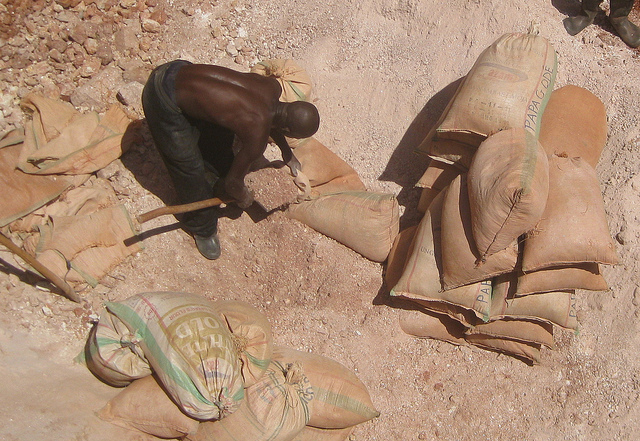
Challenges loom concerning the implementation of a Dodd-Frank provision requiring companies to disclose source minerals from war-torn regions.
About 1,200 companies recently submitted filings to the U.S. Securities and Exchange Commission (SEC) on a topic not often associated with securities regulation: the ongoing armed conflict in the Democratic Republic of the Congo (DRC). Some rebel groups in the Sub-Saharan African nation have funded their activities in the decades-long conflict with proceeds from mineral mines or processing facilities in the war-torn region. Congress attempted to limit financial flows to these rebel groups with language tucked deep in the 2010 financial regulatory reform law by requiring companies to disclose their use of “conflict minerals.”
The “conflict minerals provision” contained in Dodd-Frank Wall Street Reform and Consumer Protection Act instructed the SEC to develop reporting requirements for companies producing goods containing tantalum, tin, tungsten, or gold. Use of these four identified conflict minerals spans a multitude of products, from jet engines to food packaging to mobile phones to light bulbs. Congress anticipated mandatory disclosure would likely prompt the public to scrutinize firms’ mineral sourcing and pressure companies to transition to conflict-free suppliers.
The SEC’s conflict mineral rule, which went into effect in November 2012, requires publicly traded manufacturing companies to disclose the national origin of any of the four conflict minerals they use, if the minerals are “necessary to the functionality or production” of a product. If a mineral’s source is unknown, the company must conduct an investigation into its supply chain. Minerals that may come from the DRC or any of its eight bordering nations must be further traced for possible exploitation by rebel groups in the supply chain.
Companies first filed conflict minerals disclosures in 2014. According to an analysis of these disclosures by the U.S. Government Accountability Office (GAO), not even one company out of the 1,321 that filed reports could figure out whether the minerals it used helped finance rebel groups involved in the DRC conflict. Although nearly all firms inquired into their minerals’ country of origin, only one-third of the companies could determine if the conflict minerals originated in the DRC or bordering countries.
In November, several months after the GAO released its report, the Monetary Policy and Trade Subcommittee of the House Financial Services Committee convened experts from industry, academia, and U.S. and foreign governments to hear about progress with implementing the SEC’s conflict minerals rule. The hearing brought to light a number of issues underlying why the disclosure filings did not reveal the mineral sourcing information Congress intended. A GAO official testified that firms could have numerous suppliers in the chain of custody for any one mineral and may face difficulties and delays in attempting to track minerals through a complex supplier network. Additionally, the ongoing security concerns in the DRC’s mineral-rich regions inhibit efforts to investigate mineral sourcing.
In addition to the challenges faced by firms trying to investigate material obtained from within the DRC, the disclosure requirements for minerals obtained in the DRC’s surrounding region raises separate concerns. Evode Imena, Rwanda’s minister of mines, testified before the House subcommittee that by grouping together the DRC and the eight bordering nations, the SEC rule unjustly implicates Rwanda and its neighbors in the DRC’s conflict and inhibits business development in these countries.
Jeff Schwartz, a professor at the University of Utah S.J. Quinney College of Law, proposed that the SEC make some structural changes to enable the rule to actually achieve its intended purpose of raising consumer awareness by “naming and shaming” firms that use conflict minerals. Schwartz argued the SEC should direct companies to focus on mineral processing facilities instead of suppliers because the conflict status of minerals used in processing facilities information is already available thanks to an existing NGO, the Conflict Free Sourcing Initiative (CFSI). This organization investigates processing facilities, including smelters and refineries, to determine whether each facility takes appropriate precautions to ensure only conflict-free minerals pass through for processing. Of more than 300 processing facilities in the DRC and neighboring nations, CFSI has already certified 128 of them as “conflict-free.”
Under Schwartz’s proposal, firms using minerals processed in an uncertified facility would be given the opportunity to explain their choice. Conflict-free processing facilities also offer a shortcut to discovering which mines operate free from rebel exploitation. Disclosing mineral processing facilities reveals more about a company’s supply chain than “one thousand other details,” according to Schwartz, and has the important advantage of building from information that is already available from the CFSI.
The SEC’s conflict minerals rule is just one of several strategies the United States has adopted to help eliminate conflict minerals as a funding source for DRC rebel groups. State Department officials continue to work with DRC’s local security forces, build capacity among its domestic regulators, and foster cooperation among international partners to address the rebels’ exploitation of valuable minerals.
If the SEC rule is adjusted in the manner Schwartz suggested, perhaps State Department officials would find it worthwhile to promote it as a model for international partners to follow.
The image of a tantalum mine in the Democratic Republic of the Congo is the property of the Responsible Sourcing Network and is used under a Creative Commons License.



